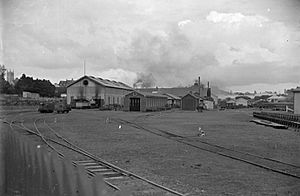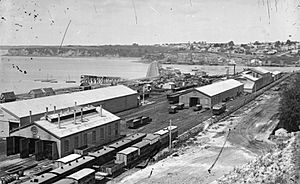Newmarket Workshops facts for kids
The Newmarket Workshops in Auckland was a very important railway workshop in New Zealand. It was one of 13 workshops across the country run by the New Zealand Railways Department. Newmarket was one of Auckland's two main railway workshops, mostly used for fixing and looking after trains. The older workshop in Newmarket was later replaced by the Otahuhu Workshops in 1929.
Contents
History of the Workshops
Early Days
The first Auckland Railway Workshops were built in 1875. They had buildings for working with metal, fixing carriages, repairing locomotives (train engines), and a boiler house. However, the place where they were built wasn't very good. It was at the start of a steep climb towards Newmarket. Because of this, people soon started planning to move the buildings to a better spot.
Moving to Newmarket
On October 13, 1879, the Public Works Department announced they had bought a good piece of land for the workshops in Newmarket. Moving the workshops also helped free up land. This land was needed to rearrange the train yard for the new Newmarket railway station.
Building the new workshops started in March 1883 and finished by November 30, 1883. The tools, machines, and workers moved to the new site between October 1884 and February 1885. The new workshops were located on both sides of Remuera Road. They stretched from Mahuru Street in the south to just north of where the North Auckland Line joined. Broadway was on the west side, and Middleton Road was on the east.
Until 1908, the Auckland railway lines were separate from the rest of the North Island's train network. During this time, the Newmarket workshops built new carriages. They also looked after all the trains used in the Auckland area. This continued until 1912. At that time, the Auckland Harbour Board started a project to reclaim land from the sea. This project included extending a road called King's Drive (now Quay Street). To do this, the place where locomotives were kept had to be moved.
The Railways Department bought more land at Newmarket for this purpose. This land was in a small valley, so a lot of earth had to be moved to prepare the site. This was done by hand, with help from horses pulling carts of dirt.
However, plans to use this new land for the locomotive sheds were later changed. The idea of moving the engine sheds from the Auckland Railway Station to Newmarket had been discussed since 1912. It was even a reason why the Parnell Tunnel might need a second tunnel. On August 1, 1914, the General Manager, E. H. Hiley, reported that the reclaimed land at Mechanics Bay would be used for extending the station yard. So, the locomotive depot would be built on reclaimed land in Hobson Bay instead. The land at Newmarket, which was meant for the depot, would now be used to make the workshops bigger.
The expansion of the Newmarket site was delayed by World War I. But the land was eventually used to build a workshop for carriages and wagons. This freed up space in other workshops for fixing locomotives. By July 21, 1916, work on the new workshops was well underway. The new buildings were ready to be used by the end of that year. These new buildings included a shed for drying timber, a wood mill, a carriage and wagon shop, a lifting shop, a blacksmiths' shop, and shops for tarpaulins and trimming.
Expert Review in 1925
In 1925, two English railway experts, Sir Sam Fay and Sir Vincent Raven, were asked to look at New Zealand Railways. They gave many suggestions for workshops around the country, especially in Auckland and Wellington. For the Newmarket site, they said the woodworking and machine shop was too small. They also noted that the layout of the yard was not good. Plus, different parts of the workshops were separated by Remuera Road. This meant trains had to move through a busy area, causing expensive delays.
In 1928, the Minister of Railways reported that workshops in the South Island could be made bigger. However, the two main workshops in the North Island, Newmarket and Petone, were not big enough. So, new land was bought at Otahuhu and Lower Hutt to build new, larger workshops to replace them.
Otahuhu Workshops Open
The new Otahuhu Workshops opened after Christmas in 1928. Soon after, the Newmarket Workshops closed down.
What They Did There
Unlike some other main workshops, Newmarket (and later Otahuhu) did not build new locomotives. They focused on repairing and maintaining trains. There were only a few exceptions. One FA class locomotive (FA 276) was built in 1896. Also, nine older F and L class locomotives were rebuilt there.
An experimental train car, called the MacEwan-Pratt Railcar, was built at Newmarket in 1912. But it didn't work very well and was taken apart in 1913.
Today
Today, new roads and buildings have covered most of the old workshop area. It's hard to find many traces of what was once there.



